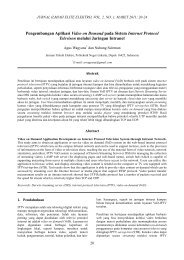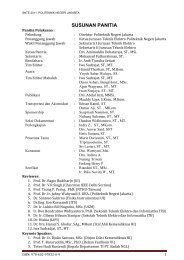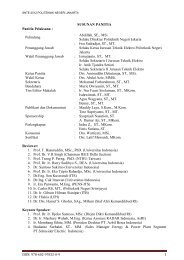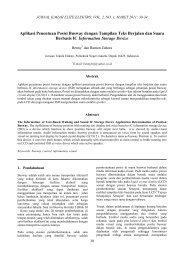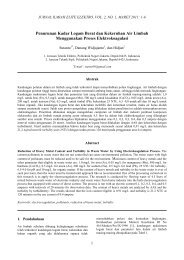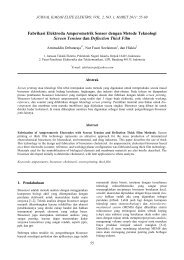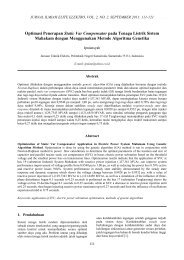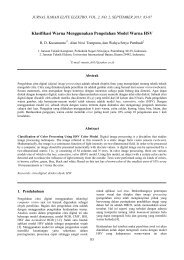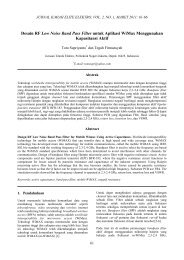Buku Prosiding Seminar Nasional Tahun 2012 - ELEKTRO ...
Buku Prosiding Seminar Nasional Tahun 2012 - ELEKTRO ...
Buku Prosiding Seminar Nasional Tahun 2012 - ELEKTRO ...
- No tags were found...
Create successful ePaper yourself
Turn your PDF publications into a flip-book with our unique Google optimized e-Paper software.
TL | 36Average Wattage(Watt)150.0100.050.00.0100.11 3 5 7 9 11 13 15 17 19 21 23Power (MW)600.0500.0400.0300.0200.0543.4 525.71 3 5 7 9 11 13 15 17 19 21 23HourHourFigure 6.Power (MW)Figure 7.80706050403020100Estimation of typical lighting load curve perhousehold in Surabaya76.31 3 5 7 9 11 13 15 17 19 21 23HourEstimation of typical lighting load curve forresidential sector in SurabayaFig. 6 and 7 depict estimation of typical lighting loadcurve per household and for residential sector inSurabaya, respectively, taken into account 96.2% inlamp share of ownership. The curve is constructedbased on each lamp power rating and their hourly usage.The peak load of lamp power consumption perhousehold is estimated occured at 7 PM with 100.1 W.Data consisting all lamps power rating together withtheir total hourly usage as gathered in Fig. 1 aretabulated to obtain hourly total lamp power (W). In Fig6, divided the hourly total power into total number ofparticipant, the average hourly lamp power consumptionper household can be determined. Similarly, multiplyingaverage hourly lamp power consumption per householdwith total number of electrified households, we canobtain the estimates lighting load curve for residentialsector in Surabaya, as depicted in Fig. 7. The peak loadfor residential lighting load in Surabaya istimatedoccured at 7 PM with 76.3 MW.Figure 8.Adjusted average system load curve forSurabaya distribution area (PT. PLN APDJatim, June – September 2011, modified)This study also considers developing the system loadcurve for Surabaya to observe coincidence betweenlighting load and system load. The 2011 original systemload curve for Surabaya distribution area was collectedfrom PT. PLN APD Jatim [5]. The system load curvedata during June – September 2011 was considered tobe observed for the purpose of month similarity with thesurvey activity which was held during June – September<strong>2012</strong>. This study uses assumption that no significantchanges have been made during one year, particularlyregarding to the lamp utilization in the residential sector.Average value of peak load during June – September2011 was obtained from the original data. However, dueto large area of PLN’s Surabaya Distribution System,we have decided to reduce the coverage area byremoving several transformers supplying into thoseareas, including those supplies industrial clusters. Asseen on Fig. 8, the adjusted system load for SurabayaDistribution System during June – September 2011shows its peak load at 3 PM with 543.4 MW.Meanwhile, the average power consumption at 7 PMwas slightly lower than that with 525.7 MW. Thismeans the lighting load curve is not coincidence withthe system load at 7 PM, although the loading forseveral areas such as Rungkut Industrial estate, Waru,and West Surabaya are excluded. The system load isstarted to increase at 8 AM when most of industry beganits operation. Commercial office followed at 9 AM, andshopping center started at 10 AM. In fact, the residentialsector also contributed for the cooling load from theutilization of air conditioning system, which in turnincreases the hourly power demand.4. ConclusionIn this paper, baseline energy use method is applied forestimating lighting load curve in residential sector. Theselected study area is Surabaya. Primary data areSNTE-<strong>2012</strong> ISBN: 978-602-97832-0-9




